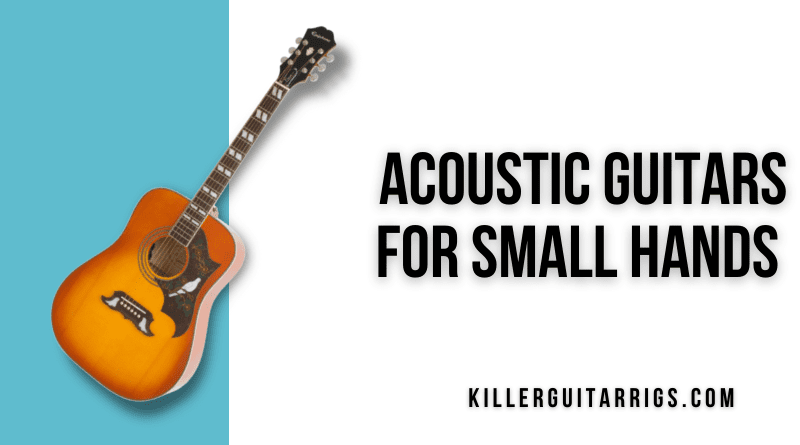If you’ve got more compact hands and you’ve been struggling to find a guitar that feels comfortable, you aren’t alone. Many players, particularly younger guitarists and women, can have a tough time finding the perfect guitar. Selecting a guitar that fits you comfortably can make a huge difference not only to your technique, but to your enthusiasm to even pick it up and practice. Those two key factors can determine your overall improvement.
While testing these guitars, we primarily looked at comfort and ergonomics to see which guitars were most suitable for smaller-handed players. In addition, we’ve compared tones and overall build quality to give you a full 360-degree view of these instruments. (You can also check out our roundup for electric guitars as well as our overall choices.)
In this KillerGuitarRigs Guide, we’ve done the legwork for you and reviewed the 5 Best Acoustic Guitars for Small Hands. Keep on reading to learn:
- Are acoustic guitars for smaller hands different from other guitars?
- What to look for in a guitar for narrower hands?
- And much more!
Read more about our review process.
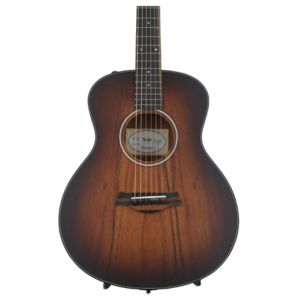
Taylor GS Mini-e Koa Plus
Features: Solid koa top, 23.5" Scale, ES2 Electronics
Benefits: Exceptional comfort, Exotic tones, High end electronics
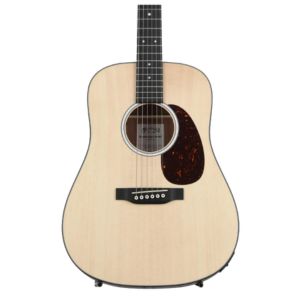
Martin D Jr-10e
Features: Reduced body size, 24" scale, Solid spruce top
Benefits: Bright tones, Comfortable neck, Plenty of volume
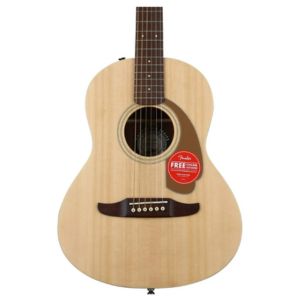
Fender Sonoran Mini
Features: Solid spruce top, 24.1" Scale length, Slim C Shape neck
Benefits: Comfortable playing experience, Punchy tones, Awesome vintage aesthetics
Contents
Our Top 3
Our Top Pick, the Martin D Jr-10E is a 15/16 scale guitar with a classic Martin Dreadnought profile. This guitar is packed with premium features, including a solid Sitka spruce top, sapele back and sides, scalloped X bracing, a sustainable Richlite fretboard and a Tusq saddle. The sound is very warm, and very full, which is rare to find in a scaled-down guitar. It has a great, slim neck that’s ideal for players with narrower hands.
The Fender Sonoran is our Best Budget option. It boasts a solid spruce top with mahogany back and sides, which give it a bright, almost peppy tone. The neck on the Sonoran is one of the particular highlights. The nut width is perfect for players with less reach, and the compact body also makes it a comfortable choice.
The Taylor GS Mini-e Koa Plus from Taylor Guitars was our Editor’s Pick winner. It’s a ¾ size Grand Symphony made with a solid koa top and layered koa back and sides. It looks spectacular and is tonally unmatched when it comes to smaller-scale instruments, with its bright, clear sound. It’s comfortable to hold and play, and is equipped with onboard pickups for easy recording and PA/amp connection.
Individual Reviews
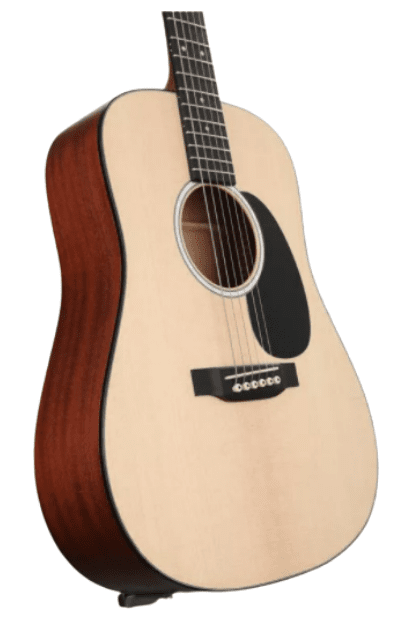
Martin D Jr-10E
Martin tones and quality in a scaled down package.
With this Martin you're getting the result of almost 2 centuries of guitar making experience. It offers exceptional tone, wonderful quality, and fantastic comfort for players with smaller hands.
It’s always a pleasure to test any Martin Guitar, and we found that the D Jr-10E was really no exception. As one of the few true dreadnought guitars in a scaled-down size, this Martin offers a means for players with a narrower grip to play what is traditionally considered one of the more unwieldy body styles.
First impressions were excellent, as we find with almost every Martin. It comes with a semi-rigid gig bag, which was genuinely one of the best we’ve ever seen. The scale length is 24” and the body is 15/16ths the size of a full-size, so it plays very similarly, but the comfort factor for smaller-handed players is much improved.
The select hardwood neck is a Dreadnought Jr shape, making it specific to this series of guitars. The nut width is quite large at 1.75”, however, the performance taper makes this neck very quick playing and the profile makes it easy for small hands to reach all 14 of the exposed frets. String spacing is 54.76mm, which is a great middle-of-the-road setup for any guitarist.
We found both strumming and fingerstyle were comfortable, as were runs up and down the neck. The fretboard is finished in Richlite, which might upset some purists, but we think any disdain toward this wood-alternative is unwarranted. It was comfortable, looks just like ebony, and it’s just as hard-wearing.
As far as tones go, it did lose a little of the fullness of a full-size dreadnought, but it’s barely a noticeable difference. We found it to be well-defined, with great midrange presence and bright highs. The Fishman Sonitone electronics worked well, and really kept the guitar’s inherent character even with amplification.
Verdict: The Martin D Jr-10E is a great choice for players with smaller hands, although it’s still comfortable for almost everybody. Its slightly smaller than full-sized body ensures you get a real Martin sound, but with ergonomics better suited for smaller-handed playres. We found the build quality to be excellent, with premium appointments used throughout.
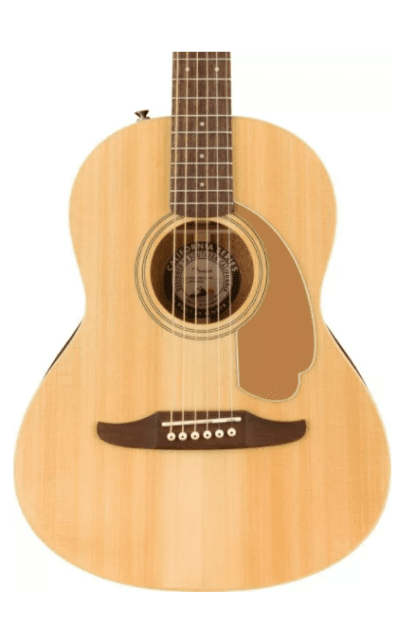
Fender Sonoran Mini
A very well appointed guitar at a price to suit all budgets.
If you're looking for a comfortable, reliable, and stylish guitar from a well respected brand at a price to suit all wallets, this reduced size Fender is guaranteed to please. It sounds wonderful, and features surprisingly high end materials and hardware considering its price.
The Sonoran Mini is one of the newest guitars in the Fender lineup and it’s certainly an impressive addition. With Fender’s electric line, we don’t see any models at this kind of price point (besides Squiers), but with a Fender Sonoran Mini, you’ll get a comfortable guitar with the iconic Stratocaster headstock, including Fender branding.
We really loved the looks of this guitar. The spruce top is accented by a caramel-colored pickguard that gives a retro, yet contemporary vibe. This is a reduced-size guitar (3/4 size) with a parlor-style body (there are also 1/2 size guitars available). It features a 24.1” scale, and a super narrow 1.615” nut. We loved how easy it was to reach for complex chords, and extended scale runs were a joy to play. Despite the narrow nut, the strings were adequately spaced, giving us room for comfortable fingerstyle playing as well as strumming.
The short scale also helps with reduction of string tension, which tends to increase comfort, since less effort is required to depress strings. This is always a big help for players with smaller hands.
The neck profile is a comfortable and modern C shape, which really promotes a neutral grip, allowing smaller-handed players to reach the frets without having to compensate. The neck itself is made of Nato wood, and the fretboard is finished in walnut, which not only looks great, but it’s hard-wearing and very responsive.
It comes with a gig bag, which is surprising considering the already low price of this guitar. It isn’t quite up to the standard of the Martin and Taylor gig bags we got with the D Jr and the GS Mini, but it’s more than sufficient for storage or taking your guitar to and from lessons.
Verdict: The Fender Sonoran Mini is a genuinely wonderful guitar. If we weren’t aware of the low price, we’d assume it cost upwards of twice as much as the MSRP. It’s made with quality tone woods and the vintage looks check all the boxes. We found that the neck is slim enough for both kids and adults with smaller hands. Because of that, the Fender brand prestige, and the low price, this guitar makes a great gift option!
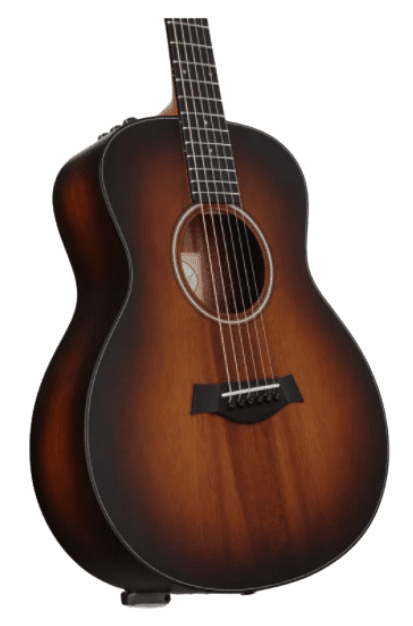
Taylor GS Mini-e Koa Plus
A bold voiced guitar with all the comfort you’re looking for.
Players with smaller hands who won't accept compromise should definitely take a look at this Taylor. It's compact, and offers wonderful ergonomics, making it comfortable for every player, and it's made with the finest woods, resulting in a sweet tone unmatched in this category.
Buyers without budget limitations should really be considering the GS Mini-e Koa Plus (or its cheaper cousin the GS Mini Mahogony). We were floored when opening this guitar! Koa is undeniably one of the prettiest tone woods, and the top was stunning. It came with a semi-rigid Taylor gig bag, which provided ample protection and plenty of space for accessories.
The scale length is a short 23.5”, further reducing the string tension, even over the extremely comfortable Fender Sonoran Mini. It’s a ¾-size body with 20 frets on a slim, soft V profile, mahogany neck. The nut width is just 1.6875”, making it easily manageable for those with even the smallest hands. The fretboard is made from solid ebony, which is visually very appealing and felt great under the fingers.
Playability was superb. We found that the neck was fast and we were able to play fingerstyle, quick runs, and complex chords without any struggle whatsoever. The action was nice and low right out of the box, and we found the body to be very comfortable for smaller players.
The electronics are Taylor’s in house ES2 (expression system 2) pickups. The volume and tone controls are easily accessible without being intrusive, and we found that the pickups keep the organic acoustic tones very well.
Tonally, the GS Mini-e Koa Plus had a rich, bold sound, which you’d never guess came from a ¾-size instrument. The bass end is powerful and warm, but the clarity and brightness we got when fingerpicking was amazing. Overall, this is a very versatile guitar that plays like a full-size Taylor, while retaining the comfort of a smaller guitar (full review here).
Verdict: Players with narrower hands have been turning to the Taylor GS Mini-e Koa, and the rest of the GS Mini family of guitars, for years now. We can’t recommend this particular model highly enough. We really loved everything about it, especially the depth and character that comes with the beautiful koa top. The neck was among the very best for players with small hands and the body size makes it very easy to handle.
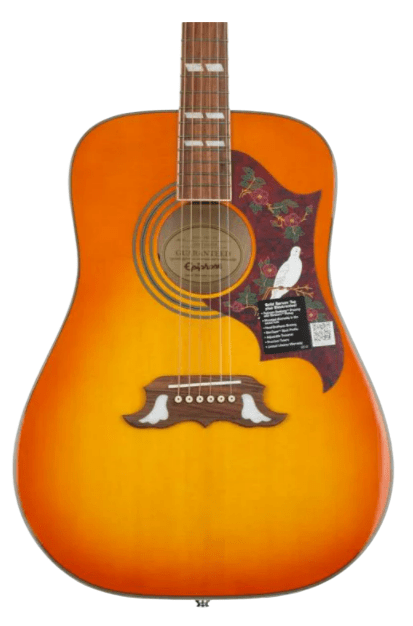
Epiphone Dove
A full size dreadnought with a slim, comfortable neck.
If you need the volume and projection of a full size dreadnought, but struggle with fat necks, the Epiphone Dove might just be the answer. It's a full voiced, booming acoustic, with a brilliantly comfortable neck that makes for comfy barre chords and easy runs up and down the fretboard.
While Epiphone is now mostly known for making entry-level licensed replicas of Gibson guitars, they have a rich brand history of their own, with some notable acoustic guitars having been made in their past. This model, the Epiphone Dove is inspired by the iconic Gibson Dove from 1962, in this case, built with a slim, fast-playing neck.
The color we had for this test was a classic Violin Burst, but it’s also available in a Sweetwater-exclusive Trans Ebony. Scale length is a full 25.5”, which did increase string tension, making it a little less comfortable than the other models on test. Regardless, it was still very playable. The Indian Laurel fretboard’s pores were a little more open than we’d prefer, but they’ll close up with time and use.
The neck is a slim taper D profile made from hard maple. This profile is also in use on many of Epiphone’s electric models. It was comfortable and lightning fast, and paired with the 1.68” nut width, this guitar makes a great choice for any player with smaller hands who is insistent on a full-size guitar with a comfortable neck.
If you’re under 5’6” you might have some difficulty handling the body of this guitar. As a full-size dreadnought, the body is much deeper than the smaller models we’ve included in this review. Of course, the advantage of having a full-size body is the breadth of tone.
We got full, rich bass response and a nice sparkly top end, although the mids were a little lacking. The top is solid spruce, and the back and sides are maple, a great combination for punch and clarity. We found the Dove did well when played loud, but lost some nuance on quieter pieces.
The Fishman Sonitone electronics performed well, and as they did on the Martin, retaining most of the Dove’s acoustic character when amplified.
Verdict: The Epiphone Dove is one of the best-value acoustic guitars for smaller-handed guitarists, without giving up a full-size body and full scale. We definitely recommend this for guitarists who may be taller (5’8” and above), but perhaps have shorter fingers or narrower hands. The quality is great, and the gloss finish is hard-wearing and designed to last.
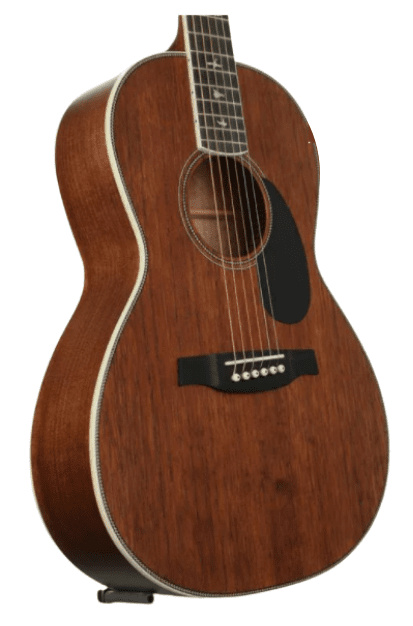
PRS SE Parlor P20
A parlor guitar designed for the amateur and working musician alike.
This PRS is a fantastic choice for smaller handed guitarists. It's brilliantly playable, with a killer neck, and great action, and the tones are out of this world.
PRS are relatively new in the acoustic niche, but they’ve done a superb job with their P20 parlor acoustic. Of course, parlor guitars like this aren’t necessarily designed for guitarists with small hands, but they just so happen to perfect line up with the needs of many of those players.
On paper, you’d never think this would be a good fit for small-handed guitar players. After all, the P20’s neck profile is the PRS Wide Fat, and if you’re looking for something for smaller hands, that doesn’t sound like the best choice! You’ll be pleased to know that hands-on experience ran counter to expectations. Yes, the profile is wide fat, but the nut is narrow at 1.6875”, so that wide fat neck actually works very well, and felt great in the hand.
We didn’t find ourselves overreaching or stretching to hit notes, whether we were playing runs, barre chords, or complex jazz chords. But like the Epiphone Dove, the PRS SE P20 has a full-length scale at 24.7”, which did introduce more string tension and reduce comfort somewhat. This may not be an issue for more experienced players, but newer guitarists might find this tricky to overcome.
This is a particularly sweet-sounding guitar, with a big midrange punch and excellent upper-end clarity. Given the solid mahogany top and mahogany back and sides, we expected a much darker and moodier sound, but the smaller size provided some extra focus and tightened up the sound. This killed a lot of the lows. Fingerpicking passages were crisp and clear, with great separation, and response to both soft and heavy strumming was great, although it did struggle for volume.
Verdict: The PRS SE P20 is a bit less versatile than some of the other small-scale guitars we covered. It has a very bluesy tone, but the reduced low end might be an issue for some. The bottom end isn’t lacking per se, as you don’t truly expect a big bass response from a guitar like this, but if you are looking for a smaller instrument with a fuller tone, the Martin D Jr or the Taylor GS mini might offer more of what you’re looking for.
How to Choose The Right Guitar For You
Acoustic Guitars for players with smaller hands might appear very similar, but if you know what you’re looking for, you can easily identify those that are most suitable, which helps narrow down your choices.
Is There Anything Different About Acoustic Guitars for Smaller Hands?
Smaller-handed players have traditionally had to make do with ill-fitting instruments because there weren’t any real options available for them. This meant stretching out around baseball-bat necks and seemingly enormous fretboards. Fortunately, there is now a huge selection of guitars suitable for those with smaller grips across the entire spectrum of spec and price. Nearly all manufacturers, including the most popular acoustic guitar makers like Martin and Taylor, make reduced-scale instruments and guitars with narrow nuts, ideal for players with narrower hands.
When identifying a guitar suitable for a player with small hands, the first thing to check is the nut width. A narrow nut width is a good indicator of a slim neck overall, which should make it easy for players with narrower hands to grip and apply proper technique when transitioning between chords.
Of course, depending on the specifics of your hand anatomy, different nut widths will be comfortable. Anything under 1.7” is generally considered small, and will be a good starting point in your search for an acoustic guitar.
What Body Shapes Are Available?
The range of guitars for players with smaller hands is pretty much the same as it is for full-sized instruments:
Dreadnought
Dreadnought acoustic guitars are prized for their booming tones and huge presence. They are usually among the largest acoustics, but Martin is now making Dreadnought Jr. models, making them accessible to players with a smaller grip who have traditionally shied away from dreadnoughts due to their unwieldy dimensions. These reduced-scale dreadnoughts lose very little of the presence their larger counterparts boast, making them a great choice.
Cutaway
Acoustic guitars with a cutaway are those with a section of the upper bout removed in order to allow easier access to the high frets. Even full-size acoustic guitars with a cutaway benefit smaller-handed players due to their improved ergonomics, but when a cutaway is combined with a narrow nut or a reduced scale, it really makes for an ideal combination.
Concert Shape
Concert shape guitars are also available with narrow nuts and reduced scales for players with narrower hands. Their design is loosely based on classical guitars, and they offer superior ergonomics over dreadnought-shaped guitars, making them easier to hold for smaller players. They lose some of the volume that you’d get with a dreadnought, but make up for it with great midrange dynamics.
What to Look for When Shopping?
As we’ve highlighted, making sure your guitar is a comfortable fit for you can make an enormous difference in how you play. For anybody specifically shopping for a guitar for someone with more compact hands for the first time, you should absolutely keep an eye out for these key areas:
Narrow Nut/Slim Neck
The biggest problem area for players with smaller hands is typically being able to stretch out for chords and scales. Having a narrow nut means the neck isn’t as wide, and the profile is generally less full. This is going to give you a much easier time wrapping fingers around the neck and ultimately makes it easier to accurately depress notes.
Short Scale Length
Having a shorter scale length means having a shorter neck, so not only will it be easier to wrap your hands around to the fretboard, but it will be easier to stretch fingers up and down the fretboard. This should make soloing easier and should give you an advantage when playing more complex chord structures.
Small Body
Many players with smaller hands might also find it helpful to play a guitar with a smaller, scaled-down body. This should make it easier to physically hold the guitar when playing seated, which will give you more control over the instrument, in turn helping you to improve technique.
Light Strings
Yes, strings can be changed, but look for a guitar that is already equipped with lighter strings so there’s not too much setup required to switch to a narrower gauge. Lighter-gauge strings reduce the effort required to finger notes, which will further increase your ability to play complex chords if you’re already struggling to reach the frets.
FAQ
There’s really no hand size that can’t play guitar. No matter how small your hands may be, there’s a style or size of guitar that will fit you. There are even people with small hands who learn to play full-sized guitars comfortably.
Many say that any acoustic guitar is easy on the fingers when properly set up, though classical guitars tend to be quite easy to play out of the box. We have a whole article on low-action acoustic guitars that play easy for beginners.
While the traditional full-sized dreadnought guitar may be too big for a person with small hands, some manufacturers now make reduced-size dreadnoughts that fit a smaller player. Ideally you will want to try these in-person before making a buying decision.
Really any guitar can work for smaller hands, but arguably the best option is a ¾-size guitar or travel guitar. These are the ideal size for players with smaller hands, while not sacrificing playability or sound.
The ideal fretboard radius for smaller hands is 12″ or above, since people with small hands generally tend to find flatter, thinner necks easier to play. As ever, try before you buy to find the perfect radius for your hands.
The ideal neck shape for smaller hands is either a C or flat C shaped neck, provided it is in combination with a thin fretboard. This will give a player with small hands the opportunity to span the frets comfortably.
Final Thoughts
We hope you found this guide to be useful if you’ve been struggling to find a guitar that’s comfortable to play and sounds good. Any of these 5 acoustic guitars are going to make your playing experience far more enjoyable.
To recap – The Martin D Jr-10E is a great choice for players looking for a reduced-size dreadnought with big guitar tones. If you’re trying to keep spending to a minimum, our Best Budget pick is the Fender Sonoran Mini, which will do everything you ask of it and more. Finally, if you’re looking for the finest guitar for small hands and cost isn’t an issue, seriously consider the Taylor GS Mini-e Koa Plus. It sounds and looks incredible, and the neck profile makes it one of the most comfortable guitars on the market.

